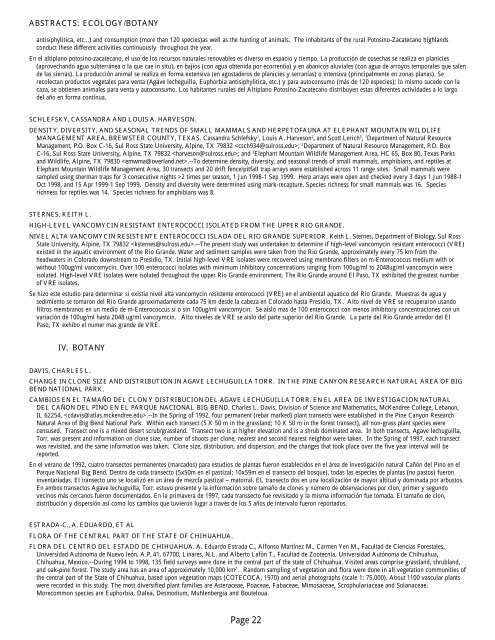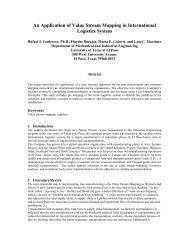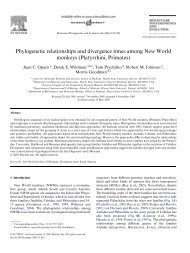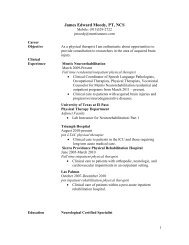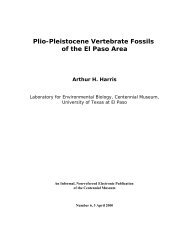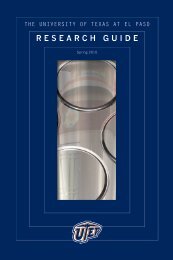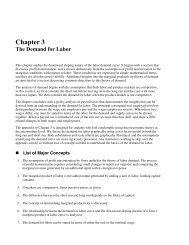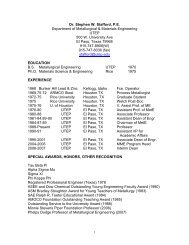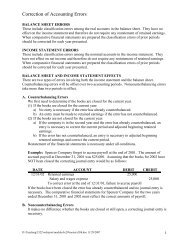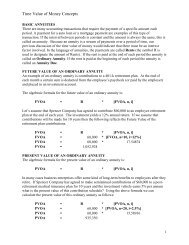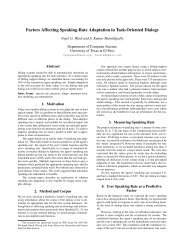Sym - Abstracts - University of Texas at El Paso
Sym - Abstracts - University of Texas at El Paso
Sym - Abstracts - University of Texas at El Paso
You also want an ePaper? Increase the reach of your titles
YUMPU automatically turns print PDFs into web optimized ePapers that Google loves.
ABSTRACTS: ECOLOGY/BOTANY<br />
antisiphylitica, etc...) and consumption (more than 120 species)as well as the hunting <strong>of</strong> animals. The inhabitants <strong>of</strong> the rural Potosino-Zac<strong>at</strong>ecano highlands<br />
conduct these different activities continuously throughout the year.<br />
En el altiplano potosino-zac<strong>at</strong>ecano, el uso de los recursos n<strong>at</strong>urales renovables es diverso en espacio y tiempo. La producción de cosechas se realiza en planicies<br />
(aprovechando agua subterránea o la que cae in situ), en bajíos (con agua obtenida por ecorrentía) y en abanicos aluviales (con agua de arroyos temporales que salen<br />
de las sierras). La producción animal se realiza en forma extensiva (en agostaderos de planicies y serranías) o intensiva (principalmente en zonas planas). Se<br />
recolectan productos vegetales para venta (Agave lecheguilla, Euphorbia antisiphylitica, etc.) y para autoconsumo (más de 120 especies); lo mismo sucede con la<br />
caza, se obtienen animales para venta y autoconsumo. Los habitantes rurales del Altiplano Potosino-Zac<strong>at</strong>ecano distribuyen estas diferentes actividades a lo largo<br />
del año en forma contínua.<br />
SCHLEFSKY, CASSANDRA AND LOUIS A. HARVESON.<br />
DENSITY, DIVERSITY, AND SEASONAL TRENDS OF SMALL MAMMALS AND HERPETOFAUNA AT ELEPHANT MOUNTAIN WILDLIFE<br />
MANAGEMENT AREA, BREWSTER COUNTY, TEXAS. Cassandra Schlefsky 1 , Louis A. Harveson 2 , and Scott Lerich 3 , 1 Department <strong>of</strong> N<strong>at</strong>ural Resource<br />
Management, P.O. Box C-16, Sul Ross St<strong>at</strong>e <strong>University</strong>, Alpine, TX 79832 ; 2 Department <strong>of</strong> N<strong>at</strong>ural Resource Management, P.O. Box<br />
C-16, Sul Ross St<strong>at</strong>e <strong>University</strong>, Alpine, TX 79832 ; and 3 <strong>El</strong>ephant Mountain Wildlife Management Area, HC 65, Box 80, <strong>Texas</strong> Parks<br />
and Wildlife, Alpine, TX 79830 .--To determine density, diversity, and seasonal trends <strong>of</strong> small mammals, amphibians, and reptiles <strong>at</strong><br />
<strong>El</strong>ephant Mountain Wildlife Management Area, 30 transects and 20 drift fence/pitfall trap arrays were established across 11 range sites. Small mammals were<br />
sampled using sherman traps for 3 consecutive nights >2 times per season, 1 Jun 1998-1 Sep 1999. Herp arrays were open and checked every 3 days 1 Jun 1988-1<br />
Oct 1998, and 15 Apr 1999-1 Sep 1999. Density and diversity were determined using mark-recapture. Species richness for small mammals was 16. Species<br />
richness for reptiles was 14. Species richness for amphibians was 8.<br />
STERNES, KEITH L.<br />
HIGH-LEVEL VANCOMYCIN RESISTANT ENTEROCOCCI ISOLATED FROM THE UPPER RIO GRANDE.<br />
NIVEL ALTA VANCOMYCIN RESISTENTE ENTEROCOCCI ISLADA DEL RIO GRANDE SUPERIOR. Keith L. Sternes, Department <strong>of</strong> Biology, Sul Ross<br />
St<strong>at</strong>e <strong>University</strong>, Alpine, TX 79832 .--The present study was undertaken to determine if high-level vancomycin resistant enterococci (VRE)<br />
existed in the aqu<strong>at</strong>ic environment <strong>of</strong> the Rio Grande. W<strong>at</strong>er and sediment samples were taken from the Rio Grande, approxim<strong>at</strong>ely every 75 km from the<br />
headw<strong>at</strong>ers in Colorado downstream to Presidio, TX. Initial high-level VRE isol<strong>at</strong>es were recovered using membrane filters on m-Enterococcus medium with or<br />
without 100ug/ml vancomycin. Over 100 enterococci isol<strong>at</strong>es with minimum inhibitory concentr<strong>at</strong>ions ranging from 100ug/ml to 2048ug/ml vancomycin were<br />
isol<strong>at</strong>ed. High-level VRE isol<strong>at</strong>es were isol<strong>at</strong>ed throughout the upper Rio Grande environment. The Rio Grande around <strong>El</strong> <strong>Paso</strong>, TX exhibited the gre<strong>at</strong>est number<br />
<strong>of</strong> VRE isol<strong>at</strong>es.<br />
Se hizo este estudio para determinar si existia nivel alta vancomycin resistente enterococci (VRE) en el ambiental aqu<strong>at</strong>ico del Rio Grande. Muestras de agua y<br />
sedimiento se tomaron del Rio Grande aproximadamente cada 75 km desde la cabeza en Colorado hasta Presidio, TX. Alto nivel de VRE se recuperaron usando<br />
filtros membranos en un medio de m-Enterococcus si o sin 100ug/ml vancomycin. Se aislo mas de 100 enterococci con menos inhibitory concentraciones con un<br />
variación de 100ug/ml hasta 2048 ug/ml vancoymcin. Alto niveles de VRE se aislo del parte superior del Rio Grande. La parte del Rio Grande arredor del <strong>El</strong><br />
<strong>Paso</strong>, TX exhibo el numer mas grande de VRE.<br />
IV. BOTANY<br />
DAVIS, CHARLES L.<br />
CHANGE IN CLONE SIZE AND DISTRIBUTION IN AGAVE LECHUGUILLA TORR. IN THE PINE CANYON RESEARCH NATURAL AREA OF BIG<br />
BEND NATIONAL PARK.<br />
CAMBIOS EN EL TAMAÑO DEL CLON Y DISTRIBUCION DEL AGAVE LECHUGUILLA TORR. EN EL AREA DE INVESTIGACION NATURAL<br />
DEL CAÑON DEL PINO EN EL PARQUE NACIONAL BIG BEND. Charles L. Davis, Division <strong>of</strong> Science and M<strong>at</strong>hem<strong>at</strong>ics, McKendree College, Lebanon,<br />
IL 62254, .--In the Spring <strong>of</strong> 1992, four permanent (rebar marked) plant transects were established in the Pine Canyon Research<br />
N<strong>at</strong>ural Area <strong>of</strong> Big Bend N<strong>at</strong>ional Park. Within each transect (5 X 50 m in the grassland; 10 X 50 m in the forest transect), all non-grass plant species were<br />
censused. Transect one is a mixed desert scrub/grassland. Transect two is <strong>at</strong> higher elev<strong>at</strong>ion and is a shrub domin<strong>at</strong>ed area. In both transects, Agave lechuguilla,<br />
Torr. was present and inform<strong>at</strong>ion on clone size, number <strong>of</strong> shoots per clone, nearest and second nearest neighbor were taken. In the Spring <strong>of</strong> 1997, each transect<br />
was revisited, and the same inform<strong>at</strong>ion was taken. Clone size, distribution, and dispersion, and the changes th<strong>at</strong> took place over the five year interval will be<br />
reported.<br />
En el verano de 1992, cu<strong>at</strong>ro transectos permanentes (marcados) para estudios de plantas fueron establecidos en el área de investigación n<strong>at</strong>ural Cañón del Pino en el<br />
Parque Nacional Big Bend. Dentro de cada transecto (5x50m en el pastizal; 10x59m en el transecto del bosque), todas las especies de plantas (no pastos) fueron<br />
inventariadas. <strong>El</strong> transecto uno se localizó en un área de mezcla pastizal – m<strong>at</strong>orral. EL transecto dos en una localización de mayor altitud y dominada por arbustos.<br />
En ambos transectos Agave lechuguilla, Torr. estuvo presente y la información sobre tamaño de clones y número de observaciones por clon, primer y segundo<br />
vecinos más cercanos fueron documentados. En la primavera de 1997, cada transsecto fue revisitado y la misma información fue tomada. <strong>El</strong> tamaño de clon,<br />
distribución y dispersión así como los cambios que tuvieron lugar a través de los 5 años de intervalo fueron reportados.<br />
ESTRADA-C., A. EDUARDO, ET AL<br />
FLORA OF THE CENTRAL PART OF THE STATE OF CHIHUAHUA.<br />
FLORA DEL CENTRO DEL ESTADO DE CHIHUAHUA. A. Eduardo Estrada C., Alfonso Martínez M., Carmen Yen M., Facultad de Ciencias Forestales,<br />
Universidad Autónoma de Nuevo león, A.P. 41, 67700, Linares, N.L. and Alberto Lafón T., Facultad de Zootecnia, Universidad Autónoma de Chihuahua,<br />
Chihuahua, Mexico.--During 1994 to 1998, 135 field surveys were done in the central part <strong>of</strong> the st<strong>at</strong>e <strong>of</strong> Chihuahua. Visited areas comprise grassland, shrubland,<br />
and oak-pine forest. The study area has an area <strong>of</strong> approxim<strong>at</strong>ely 10,000 km 2 . Random sampling <strong>of</strong> veget<strong>at</strong>ion and flora were done in all veget<strong>at</strong>ion communities <strong>of</strong><br />
the central part <strong>of</strong> the St<strong>at</strong>e <strong>of</strong> Chihuahua, based upon veget<strong>at</strong>ion maps (COTECOCA, 1970) and aerial photographs (scale 1: 75,000). About 1100 vascular plants<br />
were recorded in this study. The most diversified plant families are Asteraceae, Poaceae, Fabaceae, Mimosaceae, Scrophulariaceae and Solanaceae.<br />
Morecommon species are Euphorbia, Dalea, Desmodium, Muhlenbergia and Bouteloua.<br />
Page 22


